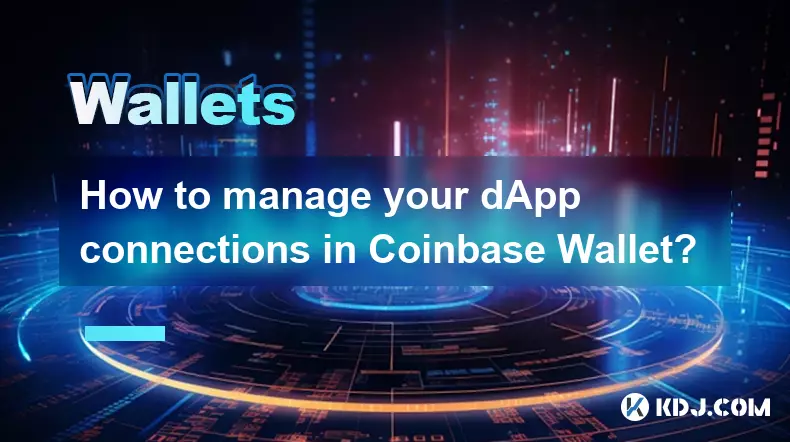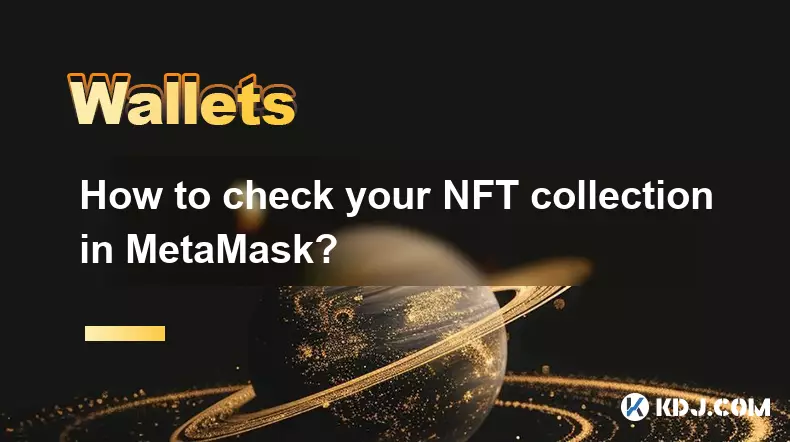-
 bitcoin
bitcoin $103128.103252 USD
-3.33% -
 ethereum
ethereum $3437.127692 USD
-4.86% -
 tether
tether $0.999700 USD
-0.02% -
 xrp
xrp $2.403993 USD
-5.73% -
 bnb
bnb $961.374676 USD
-4.11% -
 solana
solana $154.938665 USD
-8.18% -
 usd-coin
usd-coin $1.000113 USD
0.03% -
 tron
tron $0.298122 USD
0.30% -
 dogecoin
dogecoin $0.172428 USD
-5.76% -
 cardano
cardano $0.557625 USD
-7.13% -
 hyperliquid
hyperliquid $38.740701 USD
-6.51% -
 chainlink
chainlink $15.306051 USD
-7.51% -
 bitcoin-cash
bitcoin-cash $507.558648 USD
-3.26% -
 stellar
stellar $0.281899 USD
-6.74% -
 unus-sed-leo
unus-sed-leo $9.241811 USD
0.57%
How to manage your dApp connections in Coinbase Wallet?
Connecting to dApps via Coinbase Wallet is secure, as it requires user approval for each transaction and never exposes private keys.
Nov 06, 2025 at 05:10 am

Understanding dApp Connections in Coinbase Wallet
1. When interacting with decentralized applications, users must establish a connection between their Coinbase Wallet and the dApp interface. This link allows the wallet to sign transactions and verify identity without exposing private keys. The process begins by visiting a compatible dApp website or platform that supports WalletConnect or direct integration.
2. Upon accessing the dApp, a prompt appears within the Coinbase Wallet app requesting permission to connect. Users are shown the name of the dApp, its URL, and requested permissions such as access to public wallet addresses or transaction signing capabilities. Approving this request creates a secure session tied to the current browsing instance.
3. Once connected, the dApp can initiate actions like token swaps, NFT minting, or staking, all requiring user confirmation through the wallet. Each action triggers a notification inside the Coinbase Wallet mobile application, ensuring control remains with the user at every step.
4. Connection data is stored locally on the device unless manually cleared. No third party gains access to seed phrases or cryptographic keys during this process. The architecture relies on public-key cryptography to authenticate interactions while preserving privacy.
5. Disconnecting from a dApp does not affect blockchain records of past transactions but terminates ongoing communication. Future visits to the same dApp will require reauthorization unless persistent sessions are supported under user-defined settings.
Reviewing Active dApp Sessions
1. Within the Coinbase Wallet interface, navigate to the 'Settings' section and select 'Connected dApps' to view all active connections. This list includes domains, connection timestamps, and scopes of granted permissions.
2. Each entry displays whether the dApp has read-only access or extended privileges such as initiating transfers. Users should periodically audit these entries to identify unfamiliar or outdated links.
3. Selecting an individual dApp reveals detailed metadata including network origin and last interaction time. This transparency helps detect potential spoofing attempts or unauthorized integrations.
4. If suspicious activity is detected, immediate disconnection is recommended. Removing a connection severs all communication channels and invalidates any active session tokens associated with that domain.
5. There is no limit to the number of dApps one can connect to simultaneously, but maintaining fewer active links reduces exposure surface for phishing attacks or smart contract exploits.
Revoking Access and Managing Security
1. To revoke access, open the connected dApps menu and tap the red minus icon next to the relevant entry. Confirm the removal when prompted. This action cannot be undone without reconnecting manually.
2. After revocation, the dApp loses the ability to query wallet balance or propose transactions. Any pending operations must be reauthorized if the user chooses to reconnect later.
3. For enhanced protection, users can enable biometric authentication for each transaction. Even if a malicious dApp tricks a user into approving a connection, physical verification adds a critical barrier against unauthorized spending.
4. Clearing browser cache within the wallet’s internal browser also terminates ephemeral sessions. Some dApps rely on local storage to maintain state; wiping this data forces reauthentication upon return.
5. Regularly updating the Coinbase Wallet app ensures compatibility with evolving security standards and patches vulnerabilities affecting dApp interaction protocols.
Frequently Asked Questions
Can a connected dApp drain my funds without approval?No. A dApp cannot execute fund transfers without explicit user consent for each transaction. Signing requires manual confirmation via the Coinbase Wallet app, even after connection is established.
What happens if I lose my phone with active dApp connections?Losing the device doesn’t compromise funds directly. Without the recovery phrase, access to assets remains blocked. However, disconnecting sessions remotely isn't possible—securing the account depends on safeguarding the backup phrase and using secondary devices to manage holdings.
Do disconnected dApps retain any data about my wallet?After disconnection, the dApp cannot retrieve new information. However, blockchain explorers may still show historical transaction data linked to your public address. Privacy measures like address rotation help mitigate long-term tracking.
Is it safe to connect to a dApp using a shared Wi-Fi network?Connection safety depends more on application integrity than network type. While HTTPS and WalletConnect encryption protect data in transit, public networks increase risk of surveillance. Using a trusted connection minimizes interception threats during authorization.
Disclaimer:info@kdj.com
The information provided is not trading advice. kdj.com does not assume any responsibility for any investments made based on the information provided in this article. Cryptocurrencies are highly volatile and it is highly recommended that you invest with caution after thorough research!
If you believe that the content used on this website infringes your copyright, please contact us immediately (info@kdj.com) and we will delete it promptly.
- Ethereum, Altcoins, and Long-Term Gains: Navigating the Crypto Landscape
- 2025-11-12 09:00:00
- Strategy Shares, Bitcoin Retreat, and Market Pain: A NYC Perspective
- 2025-11-12 08:55:01
- Taft, Veterans, and Salutes: A Presidential Honor
- 2025-11-12 09:00:00
- Cryptos, Breakout, and Meme Coins: What's the Haps?
- 2025-11-12 09:40:01
- Altcoin Uprising: Nano, Velodrome, and the Dawn of Practical Crypto
- 2025-11-12 08:40:01
- Dogwifhat (WIF) Price Analysis: Navigating the Breakout Zone
- 2025-11-12 09:20:01
Related knowledge

Why is MetaMask asking for a signature?
Nov 10,2025 at 06:19pm
Understanding Signature Requests in MetaMaskMetaMask frequently prompts users to sign messages or transactions as part of its standard operation. Thes...

How to use MetaMask Portfolio to track assets?
Nov 08,2025 at 05:40am
Getting Started with MetaMask Portfolio1. Download and install the MetaMask mobile app from the App Store or Google Play. Open the app and select 'Imp...

MetaMask not popping up: how to fix this issue?
Nov 10,2025 at 05:59am
Understanding the MetaMask Pop-Up Issue1. MetaMask is one of the most widely used cryptocurrency wallets, especially for interacting with decentralize...

How to send ETH from Binance to MetaMask?
Nov 10,2025 at 04:40am
Sending ETH from Binance to MetaMask: A Step-by-Step GuideTransferring Ethereum (ETH) from your Binance account to your MetaMask wallet is a common op...

How to check your NFT collection in MetaMask?
Nov 06,2025 at 08:20pm
Accessing Your NFTs in MetaMask Wallet1. Open the MetaMask browser extension or mobile app and ensure you are logged into your wallet account. Once in...

Why is the MetaMask swap feature failing?
Nov 06,2025 at 09:20pm
Understanding MetaMask Swap FailuresMetaMask, one of the most widely used cryptocurrency wallets, enables users to swap tokens directly within the int...

Why is MetaMask asking for a signature?
Nov 10,2025 at 06:19pm
Understanding Signature Requests in MetaMaskMetaMask frequently prompts users to sign messages or transactions as part of its standard operation. Thes...

How to use MetaMask Portfolio to track assets?
Nov 08,2025 at 05:40am
Getting Started with MetaMask Portfolio1. Download and install the MetaMask mobile app from the App Store or Google Play. Open the app and select 'Imp...

MetaMask not popping up: how to fix this issue?
Nov 10,2025 at 05:59am
Understanding the MetaMask Pop-Up Issue1. MetaMask is one of the most widely used cryptocurrency wallets, especially for interacting with decentralize...

How to send ETH from Binance to MetaMask?
Nov 10,2025 at 04:40am
Sending ETH from Binance to MetaMask: A Step-by-Step GuideTransferring Ethereum (ETH) from your Binance account to your MetaMask wallet is a common op...

How to check your NFT collection in MetaMask?
Nov 06,2025 at 08:20pm
Accessing Your NFTs in MetaMask Wallet1. Open the MetaMask browser extension or mobile app and ensure you are logged into your wallet account. Once in...

Why is the MetaMask swap feature failing?
Nov 06,2025 at 09:20pm
Understanding MetaMask Swap FailuresMetaMask, one of the most widely used cryptocurrency wallets, enables users to swap tokens directly within the int...
See all articles


























![[4K 60fps] no care by crashpancake2 (1 Coin) [4K 60fps] no care by crashpancake2 (1 Coin)](/uploads/2025/11/12/cryptocurrencies-news/videos/6913a8862890b_image_500_375.webp)














































